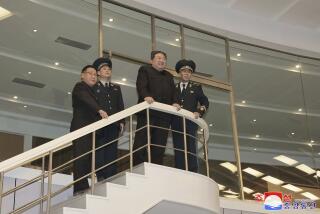‘MediaSats’: Issue With No Easy Answers
- Share via
A House subcommittee is throwing a timely spotlight on some questions that are bound to be a matter of growing controversy: What should be the restraints, if any, on the right of news organizations to publish information purchased from commercial satellite companies--or even to operate their own spy-in-the-sky “MediaSats”?
What prevails, the people’s right to know under the First Amendment or national security as defined by military men, diplomats and the intelligence agencies?
The questions are hardly theoretical.
Space satellites, once the province of intelligence agencies and the military, are already being used for communications, geophysical exploration, weather reports, navigation and crop-production forecasts. Now satellite photography is fast becoming a new frontier in the competition to be first with the news--and to bypass government, if necessary, in the process.
In a report released last week by the House space subcommittee, the Office of Technology Assessment concluded that news organizations are unlikely to be firing off their own satellites for a few years yet. Existing commercial satellites don’t take clear enough pictures to be useful in most circumstances. And the cost, so far, is high even for a cooperative venture--an estimated $215 million to $470 million to build and launch a satellite, plus $15 million a year for operations.
But, as the report also noted, the technology for news gathering from space already is available and is being used.
Jane’s Defense Weekly published a satellite photo in April that plainly supported U.S. charges that a Soviet radar installation in Siberia violates the 1972 anti-ballistic missile treaty. The source: Sweden’s commercial Space Media Network.
The first pictures of the damaged Soviet reactor site at Chernobyl were taken by the commercial U.S. EOSAT satellite, and aired on television. Additional photos were provided within days by the French SPOT satellite. One network was said to be negotiating the other day for satellite pictures of giant fires raging in China.
The specter of untrammeled media access to satellite pictures worries the Reagan Administration. It also worries Third World countries, which fear that information from satellites will be used to their disadvantage. They have pressed the United Nations for a set of international rules.
In early 1986, proposed regulations were issued that would give the secretary of commerce virtually unlimited authority to impose restrictions deemed necessary for foreign policy and national security reasons. Pentagon officials say they should have “maximum discretion” in deciding what kind of satellite photos would harm the national interest.
Final regulations are still in the drafting stage, but they are expected to assert federal authority to restrict media use of privately owned satellites. And such restrictions, if imposed, are bound to be challenged by the press.
There is no question that extensive media use of satellites, when it comes, will indeed pose some real foreign policy and national security questions.
For example, should the government have the right to block distribution of satellite photos showing U.S. preparations for a military operation where premature disclosure could cost hundreds or thousands of American lives?
Also, it’s easy to imagine a situation where India, let’s say, feels forced to attack Pakistan because satellite photos are published that are interpreted--perhaps mistakenly--to show Pakistani preparations for a nuclear weapons test.
President John F. Kennedy had several days to ponder the Soviet emplacement of missiles in Cuba and decide upon appropriate action before disclosing the situation to the American people. Would his response have been as measured, and the outcome as fortunate, if the media had forced his hand by publishing and broadcasting satellite photos of the Soviet missiles days earlier?
President Jimmy Carter was forced into a row with Moscow over a Soviet “regiment” in Cuba--which in fact had been there for years--because the late Sen. Frank Church (D-Idaho) disclosed its existence.
Some officials worry that similar overreactions could result from media misinterpretation of information obtained from satellite photos.
Diplomats fear that the U.S. government would find itself in frequent hot water with friendly countries over disclosure by media-sponsored satellites of things that these countries consider to be military secrets.
Stansfield Turner, former CIA director, has proposed creation of a government organization to facilitate the public release of all satellite-garnered information, including that from intelligence space vehicles, that would not jeopardize national interests. Such ideas don’t sit well with newsmen, who are unwilling to let the First Amendment be overridden by officials whose natural instinct is to stifle the flow of information, whether it comes from satellites or Earth-bound sources.
Since U.S. commercial satellites must be licensed by the federal government, the means of control are theoretically at hand.
However, Supreme Court decisions have established that, while the right to free speech is not absolute, the government must prove that dissemination of certain information will cause direct, immediate and serious harm to a compelling national interest. That’s a tough standard to meet.
In any event, how could any court ruling or set of controls in this country prevent a news organization from purchasing satellite photos from commercial services in other countries? Only an international agreement could conceivably do the trick--and that seems unlikely.
Still, intelligent editors won’t put too much faith in such comfortable calculations; all it would take is one diplomatic or military disaster stemming from questionable use of satellite images to stir an emotional public backlash against media “irresponsibility.”
Fortunately, the cost barriers to routine media use of satellite photos buy some time in which reasonable people on both sides can grope toward a reasonable, preferably informal accommodation.
More to Read
Sign up for Essential California
The most important California stories and recommendations in your inbox every morning.
You may occasionally receive promotional content from the Los Angeles Times.










